人教版(2019)选择性必修 第二册Unit 5 First Aid Reading and Thinking 课件(共19张PPT)
文档属性
| 名称 | 人教版(2019)选择性必修 第二册Unit 5 First Aid Reading and Thinking 课件(共19张PPT) | 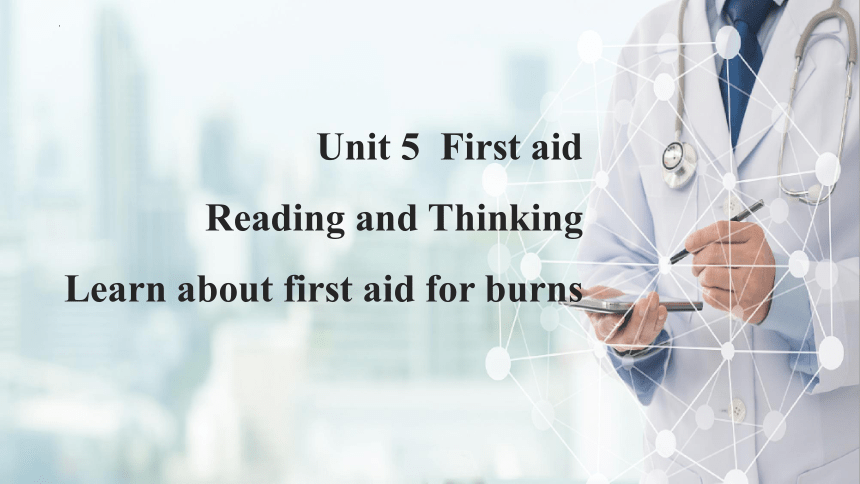 | |
| 格式 | pptx | ||
| 文件大小 | 6.7MB | ||
| 资源类型 | 教案 | ||
| 版本资源 | 人教版(2019) | ||
| 科目 | 英语 | ||
| 更新时间 | 2023-05-23 16:07:33 | ||
图片预览

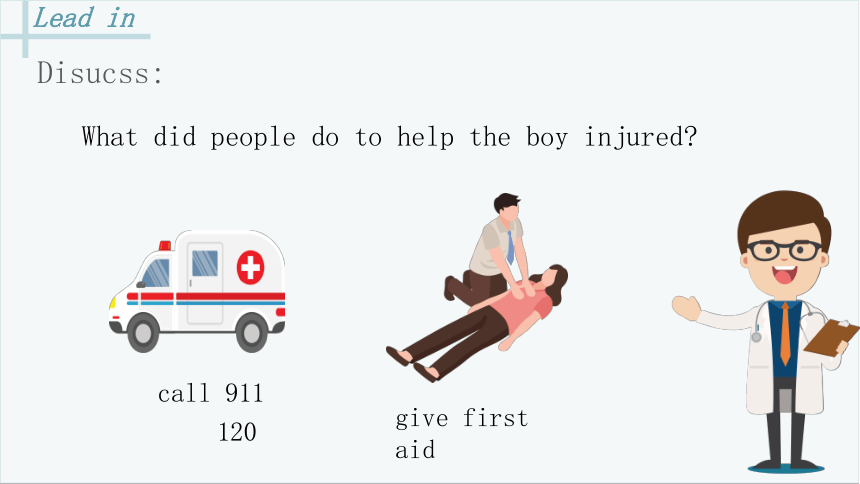
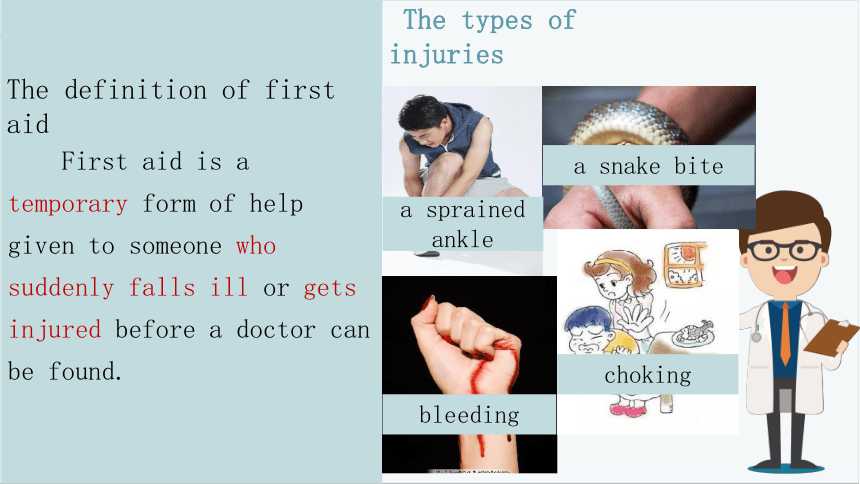
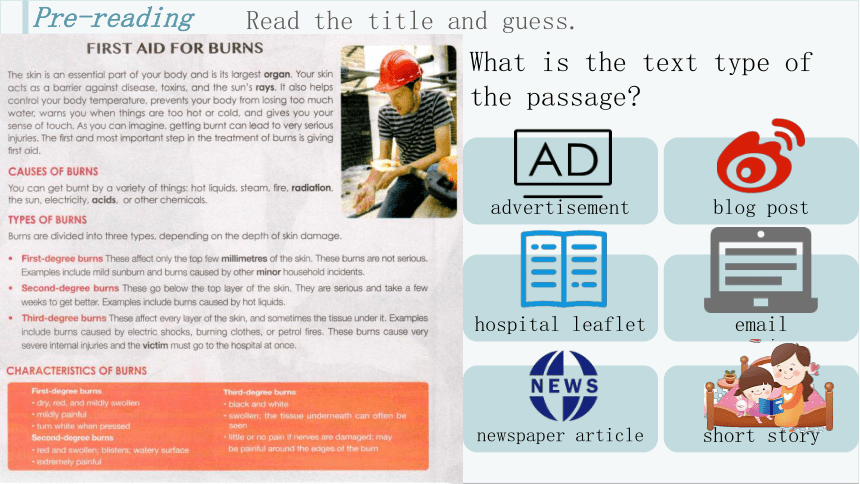
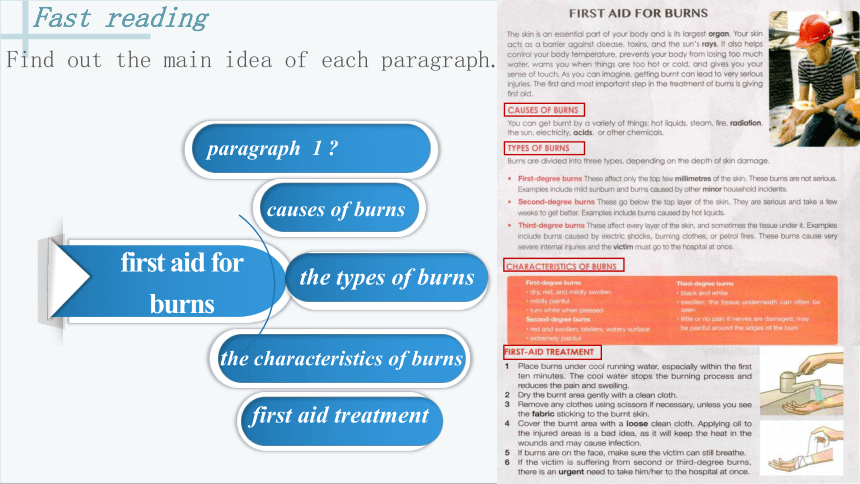

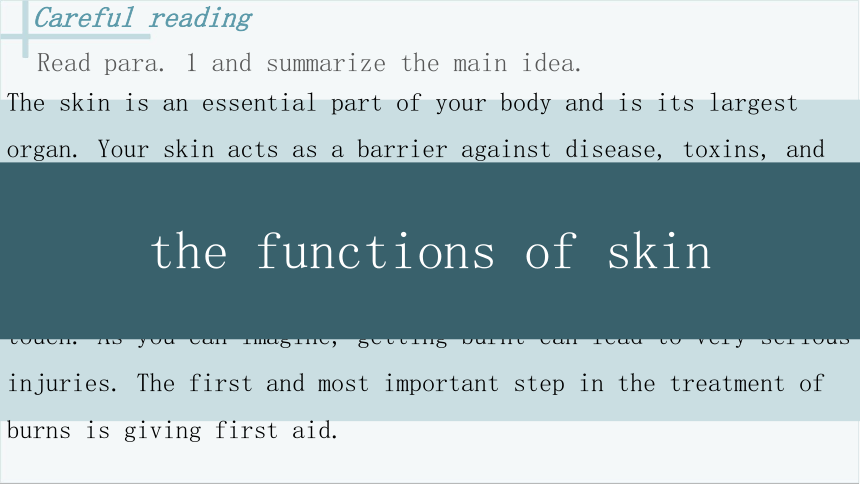
文档简介
(共19张PPT)
Unit 5 First aid
Reading and Thinking
Learn about first aid for burns
Lead in
Disucss:
What did people do to help the boy injured
call 911
give first aid
120
The types of injuries
First aid is a temporary form of help given to someone who suddenly falls ill or gets injured before a doctor can be found.
The definition of first aid
a sprained ankle
bleeding
a snake bite
choking
Pre-reading
Read the title and guess.
What is the text type of the passage
advertisement
blog post
hospital leaflet
email
newspaper article
short story
Fast reading
Find out the main idea of each paragraph.
first aid for burns
paragraph 1
causes of burns
the types of burns
the characteristics of burns
the types of burns
first aid treatment
Careful reading
The skin is an essential part of your body and is its largest organ. Your skin acts as a barrier against disease, toxins, and the sun's rays. It also helps control your body temperature, prevents your body from losing too much water, warns you when things are too hot or cold, and gives you your sense of touch. As you can imagine, getting burnt can lead to very serious injuries. The first and most important step in the treatment of burns is giving first aid.
adj. 极其重要的
n. 器官
充当...;起...作用
n. 毒素
n. 光线,射线
触觉
as引导的非限定从
进行急救
阻止,妨碍
Read para. 1 and summarize the main idea.
Careful reading
Read para. 1 and summarize the main idea.
The skin is an essential part of your body and is its largest organ. Your skin acts as a barrier against disease, toxins, and the sun's rays. It also helps control your body temperature, prevents your body from losing too much water, warns you when things are too hot or cold, and gives you your sense of touch. As you can imagine, getting burnt can lead to very serious injuries. The first and most important step in the treatment of burns is giving first aid.
the functions of skin
Careful reading
CAUSES OF BURNS
You can get burnt by a variety of things: hot liquids, steam, fire, radiation, the sun, electricity, acids, or other chemicals.
各种各样的
n. 辐射,放射线
n. 酸
Careful reading
Read para. 3 and answer the questions.
How many types of burns are there?
In each type, which layer of the skin is affected
The third layer
The second layer
The top layer
n. 层,表层
Careful reading
TYPES OF BURNS
Burns are divided into three types, depending on the depth of skin damage.
First-degree burns These affect only the top few millimetres of the skin. These burns are not serious. Examples include mild sunburn and burns caused by other minor household incidents.
Second-degree burns These go below the top layer of the skin. They are serious and take a few weeks to get better. Examples include burns caused by hot liquids.
Third-degree burns These affect every layer of the skin, and sometimes the tissue under it. Examples include burns caused by electric shocks, burning clothes, or petrol fires. These burns cause very severe internal injuries and the victim must go to the hospital at once.
被划分成
现在分词短语作方式状语
毫米(mm)
过去分词短语作后置定语
触电,电击
内伤
n. 受害者,患者
Careful reading
Read para. 3 and answer the questions.
How many types of burns are there?
In each type, which layer of the skin is affected
The third layer
The second layer
The top layer
First-degree burns
Second-degree burns
Third-degree burns
Careful reading
top few millimeters
below the top layer
every layer
the tissues
P 51
CHARACTERISTICS OF BURNS
First-degree burns
dry, red, and mildly swollen
mildly painfull
turn white when pressed
FIRST-AID TREATMENT
1 Place burns under cool running water, especially within the first ten minutes. The cool water stops the burning process and reduces the pain and swelling.
2 Dry the burnt area gently with a clean cloth.
3 Remove any clothes using scissors if necessary, unless you see the fabric sticking to the burnt skin.
4 Cover the burnt area with a loose clean cloth. Applying oil to the injured areas is a bad idea, as it will keep the heat in the wounds and may cause infection.
5 If burns are on the face, make sure the victim can still breathe.
6 If the victim is suffering from second or third-degree burns, there is an urgent need to take him/her to the hospital at once.
Second-degree burns
red and swollen; blisters; watery surface
extremely painful
Third-degree
burns black and white
swollen, the tissue underneath can often be seen
little or no pain if nerves are damaged; maybe painful around the edges of the burn
top few millimeters
below the top layer
every layer
the tissues
swollen
painful
white
blisters
watery
painful
the tissue underneath
nerves
cool running water
dry
remove any
cover
still breathe
the hospital at once
微肿的
表层渗液
皮下组织
n. 边缘
流动的冷水
现在分词短语做方式状语
if型省略句,省略了it’s
沾到...上
将...涂到...上
引导原因状从
迫切需要做某事
when型省略句
Careful reading
Decide if the following statements are true (T) or false (F).
1. Your skin gives you protection from many dangerous things.
2. A first-degree burn has this name because it is the most serious.
3. Second-degree burns can be the most painful kind of burn.
4. It is important to use cool water to stop the heat from remaining in the wound regardless of the degree of the burn.
5. Putting butter or oil on burns helps because it may reduce swelling and ease discomfort.
T
F
T
T
F
third-degree
hurts
the heat and cause infection.
keep
Critical thinking
What can we do to avoid burns
A wise man will nip in the bud.
智者防患于未然
Critical thinking
How can we prevent these burns
When you go out at daytime...
Situation 1
sun rays
Situation 2
When you are cooking in the kitchen ...
fire
(gloves...)
(sunsreen, hat...)
Post reading
Fill in the blank with the proper form of the words.
The skin is 1. essential part of your body which acts 2. a barrier against disease, toxins, and the sun’s rays. It also helps control your body temperature, prevents your body 3. losing too much water, 4._______(warn) you when things are too hot or cold, and gives you your sense of touch. As you can imagine, getting burnt can lead to very serious injuries. The first and most important step in the 5. (treat) of burns is giving first aid.
You can get 6. (burn) by a variety of things:hot liquids, steam, fire, radiation, the sun, electricity, acids or other chemicals. Burns are divided into three types, which 7. (call) first-, second-, or third-degree burns, 8.____________ (depend) on the depth of skin damage. Different degree 9. _ (burn) can be treated 10. (different). Let’s keep these things in mind.
an
as
from
warns
treatment
burnt
are called
burns
differently
depending
Thank you
FIRST AID FOR BURNS
The skin is an essential part of your body and is its largest organ. Your skin acts as a barrier against disease, toxins, and the sun's rays. It also helps control your body temperature, prevents your body from losing too much water, warns you when things are too hot or cold, and gives you your sense of touch. As you can imagine, getting burnt can lead tovery serious injuries. The first and most important step in the treatment of burns is giving first aid.
CAUSES OF BURNS
You can get burnt by a variety of things: hot liquids, steam, fire, radiation, the sun, electricity, acids, or other chemicals.
TYPES OF BURNS
Burns are divided into three types, depending on the depth of skin damage.
First-degree burns These affect only the top few millimetres of the skin. These burns are not serious. Examples include mild sunburn and burns caused by other minor household incidents.
Second-degree burns These go below the top layer of the skin. They are serious and take a few weeks to get better. Examples include burns caused by hot liquids.
Third-degree burn These affect every layer of the skin, and sometimes the tissue under it. Examples include burns caused by electric shocks, burning clothes, or petrol fires. These burns cause very severe internal injuries and the victim must go to the hospital at once.
CHARACTERISTICS OF BURNS
First-degree burns
dry, red, and mildly swollen
mildly painfull
turn white when pressed
FIRST-AID TREATMENT
1 Place burns under cool running water, especially within the first ten minutes. The cool water stops the burning process and reduces the pain and swelling.
2 Dry the burnt area gently with a clean cloth.
3 Remove any clothes using scissors if necessary, unless you see the fabric sticking to the burnt skin.
4 Cover the burnt area with a loose clean cloth. Applying oil to the injured areas is a bad idea, as it will keep the heat in the wounds and may cause infection.
5 If burns are on the face, make sure the victim can still breathe.
6 If the victimis suffering from second or third-degree burns, there is an urgent need to take him/her to the hospital at once.
Second-degree burns
red and swollen; blisters; watery surface
extremely painful
Third-degree burns
black and white
swollen, the tissue underneath can often be seen
little or no pain if nerves are damaged; maybe painful around the edges of the burn
Unit 5 First aid
Reading and Thinking
Learn about first aid for burns
Lead in
Disucss:
What did people do to help the boy injured
call 911
give first aid
120
The types of injuries
First aid is a temporary form of help given to someone who suddenly falls ill or gets injured before a doctor can be found.
The definition of first aid
a sprained ankle
bleeding
a snake bite
choking
Pre-reading
Read the title and guess.
What is the text type of the passage
advertisement
blog post
hospital leaflet
newspaper article
short story
Fast reading
Find out the main idea of each paragraph.
first aid for burns
paragraph 1
causes of burns
the types of burns
the characteristics of burns
the types of burns
first aid treatment
Careful reading
The skin is an essential part of your body and is its largest organ. Your skin acts as a barrier against disease, toxins, and the sun's rays. It also helps control your body temperature, prevents your body from losing too much water, warns you when things are too hot or cold, and gives you your sense of touch. As you can imagine, getting burnt can lead to very serious injuries. The first and most important step in the treatment of burns is giving first aid.
adj. 极其重要的
n. 器官
充当...;起...作用
n. 毒素
n. 光线,射线
触觉
as引导的非限定从
进行急救
阻止,妨碍
Read para. 1 and summarize the main idea.
Careful reading
Read para. 1 and summarize the main idea.
The skin is an essential part of your body and is its largest organ. Your skin acts as a barrier against disease, toxins, and the sun's rays. It also helps control your body temperature, prevents your body from losing too much water, warns you when things are too hot or cold, and gives you your sense of touch. As you can imagine, getting burnt can lead to very serious injuries. The first and most important step in the treatment of burns is giving first aid.
the functions of skin
Careful reading
CAUSES OF BURNS
You can get burnt by a variety of things: hot liquids, steam, fire, radiation, the sun, electricity, acids, or other chemicals.
各种各样的
n. 辐射,放射线
n. 酸
Careful reading
Read para. 3 and answer the questions.
How many types of burns are there?
In each type, which layer of the skin is affected
The third layer
The second layer
The top layer
n. 层,表层
Careful reading
TYPES OF BURNS
Burns are divided into three types, depending on the depth of skin damage.
First-degree burns These affect only the top few millimetres of the skin. These burns are not serious. Examples include mild sunburn and burns caused by other minor household incidents.
Second-degree burns These go below the top layer of the skin. They are serious and take a few weeks to get better. Examples include burns caused by hot liquids.
Third-degree burns These affect every layer of the skin, and sometimes the tissue under it. Examples include burns caused by electric shocks, burning clothes, or petrol fires. These burns cause very severe internal injuries and the victim must go to the hospital at once.
被划分成
现在分词短语作方式状语
毫米(mm)
过去分词短语作后置定语
触电,电击
内伤
n. 受害者,患者
Careful reading
Read para. 3 and answer the questions.
How many types of burns are there?
In each type, which layer of the skin is affected
The third layer
The second layer
The top layer
First-degree burns
Second-degree burns
Third-degree burns
Careful reading
top few millimeters
below the top layer
every layer
the tissues
P 51
CHARACTERISTICS OF BURNS
First-degree burns
dry, red, and mildly swollen
mildly painfull
turn white when pressed
FIRST-AID TREATMENT
1 Place burns under cool running water, especially within the first ten minutes. The cool water stops the burning process and reduces the pain and swelling.
2 Dry the burnt area gently with a clean cloth.
3 Remove any clothes using scissors if necessary, unless you see the fabric sticking to the burnt skin.
4 Cover the burnt area with a loose clean cloth. Applying oil to the injured areas is a bad idea, as it will keep the heat in the wounds and may cause infection.
5 If burns are on the face, make sure the victim can still breathe.
6 If the victim is suffering from second or third-degree burns, there is an urgent need to take him/her to the hospital at once.
Second-degree burns
red and swollen; blisters; watery surface
extremely painful
Third-degree
burns black and white
swollen, the tissue underneath can often be seen
little or no pain if nerves are damaged; maybe painful around the edges of the burn
top few millimeters
below the top layer
every layer
the tissues
swollen
painful
white
blisters
watery
painful
the tissue underneath
nerves
cool running water
dry
remove any
cover
still breathe
the hospital at once
微肿的
表层渗液
皮下组织
n. 边缘
流动的冷水
现在分词短语做方式状语
if型省略句,省略了it’s
沾到...上
将...涂到...上
引导原因状从
迫切需要做某事
when型省略句
Careful reading
Decide if the following statements are true (T) or false (F).
1. Your skin gives you protection from many dangerous things.
2. A first-degree burn has this name because it is the most serious.
3. Second-degree burns can be the most painful kind of burn.
4. It is important to use cool water to stop the heat from remaining in the wound regardless of the degree of the burn.
5. Putting butter or oil on burns helps because it may reduce swelling and ease discomfort.
T
F
T
T
F
third-degree
hurts
the heat and cause infection.
keep
Critical thinking
What can we do to avoid burns
A wise man will nip in the bud.
智者防患于未然
Critical thinking
How can we prevent these burns
When you go out at daytime...
Situation 1
sun rays
Situation 2
When you are cooking in the kitchen ...
fire
(gloves...)
(sunsreen, hat...)
Post reading
Fill in the blank with the proper form of the words.
The skin is 1. essential part of your body which acts 2. a barrier against disease, toxins, and the sun’s rays. It also helps control your body temperature, prevents your body 3. losing too much water, 4._______(warn) you when things are too hot or cold, and gives you your sense of touch. As you can imagine, getting burnt can lead to very serious injuries. The first and most important step in the 5. (treat) of burns is giving first aid.
You can get 6. (burn) by a variety of things:hot liquids, steam, fire, radiation, the sun, electricity, acids or other chemicals. Burns are divided into three types, which 7. (call) first-, second-, or third-degree burns, 8.____________ (depend) on the depth of skin damage. Different degree 9. _ (burn) can be treated 10. (different). Let’s keep these things in mind.
an
as
from
warns
treatment
burnt
are called
burns
differently
depending
Thank you
FIRST AID FOR BURNS
The skin is an essential part of your body and is its largest organ. Your skin acts as a barrier against disease, toxins, and the sun's rays. It also helps control your body temperature, prevents your body from losing too much water, warns you when things are too hot or cold, and gives you your sense of touch. As you can imagine, getting burnt can lead tovery serious injuries. The first and most important step in the treatment of burns is giving first aid.
CAUSES OF BURNS
You can get burnt by a variety of things: hot liquids, steam, fire, radiation, the sun, electricity, acids, or other chemicals.
TYPES OF BURNS
Burns are divided into three types, depending on the depth of skin damage.
First-degree burns These affect only the top few millimetres of the skin. These burns are not serious. Examples include mild sunburn and burns caused by other minor household incidents.
Second-degree burns These go below the top layer of the skin. They are serious and take a few weeks to get better. Examples include burns caused by hot liquids.
Third-degree burn These affect every layer of the skin, and sometimes the tissue under it. Examples include burns caused by electric shocks, burning clothes, or petrol fires. These burns cause very severe internal injuries and the victim must go to the hospital at once.
CHARACTERISTICS OF BURNS
First-degree burns
dry, red, and mildly swollen
mildly painfull
turn white when pressed
FIRST-AID TREATMENT
1 Place burns under cool running water, especially within the first ten minutes. The cool water stops the burning process and reduces the pain and swelling.
2 Dry the burnt area gently with a clean cloth.
3 Remove any clothes using scissors if necessary, unless you see the fabric sticking to the burnt skin.
4 Cover the burnt area with a loose clean cloth. Applying oil to the injured areas is a bad idea, as it will keep the heat in the wounds and may cause infection.
5 If burns are on the face, make sure the victim can still breathe.
6 If the victimis suffering from second or third-degree burns, there is an urgent need to take him/her to the hospital at once.
Second-degree burns
red and swollen; blisters; watery surface
extremely painful
Third-degree burns
black and white
swollen, the tissue underneath can often be seen
little or no pain if nerves are damaged; maybe painful around the edges of the burn
